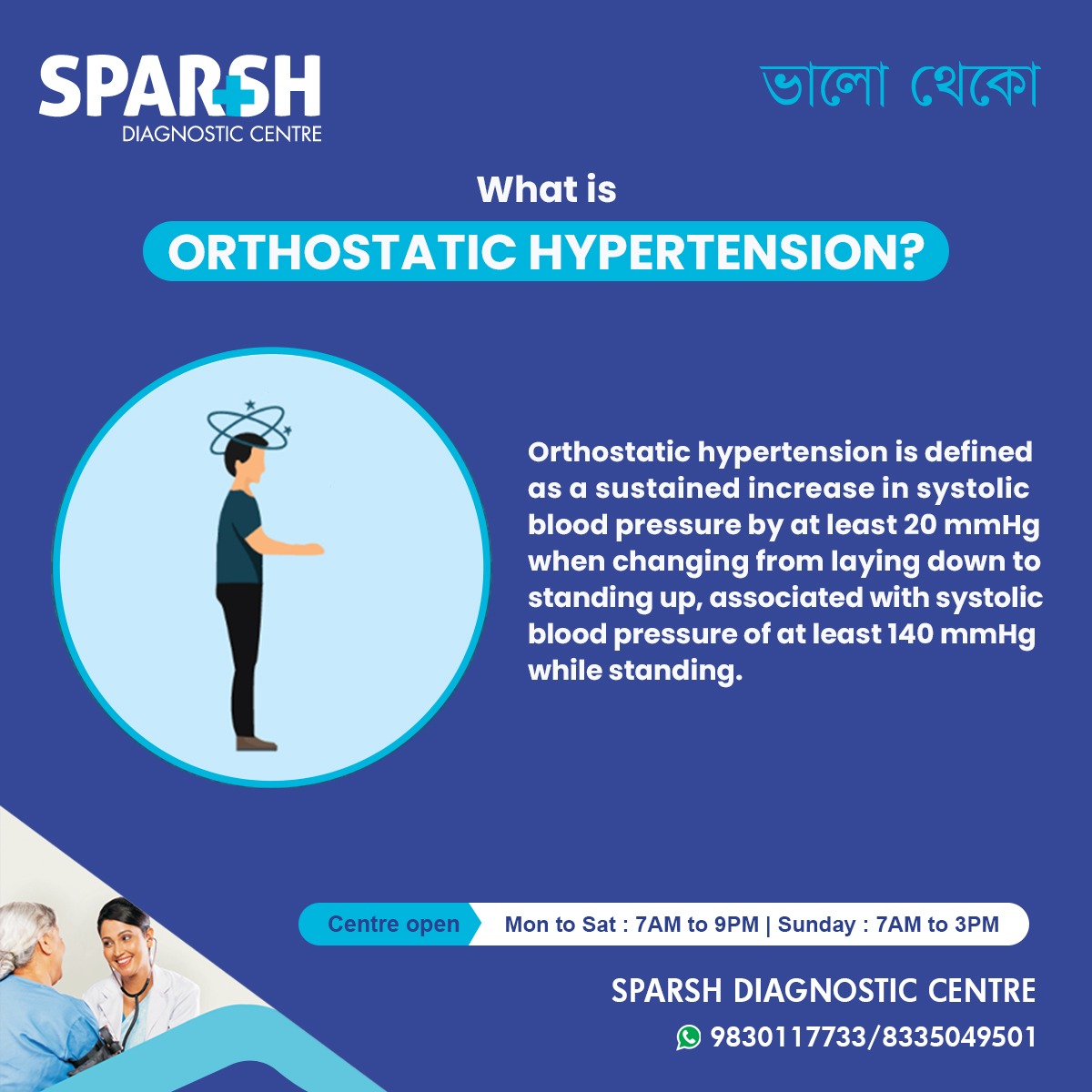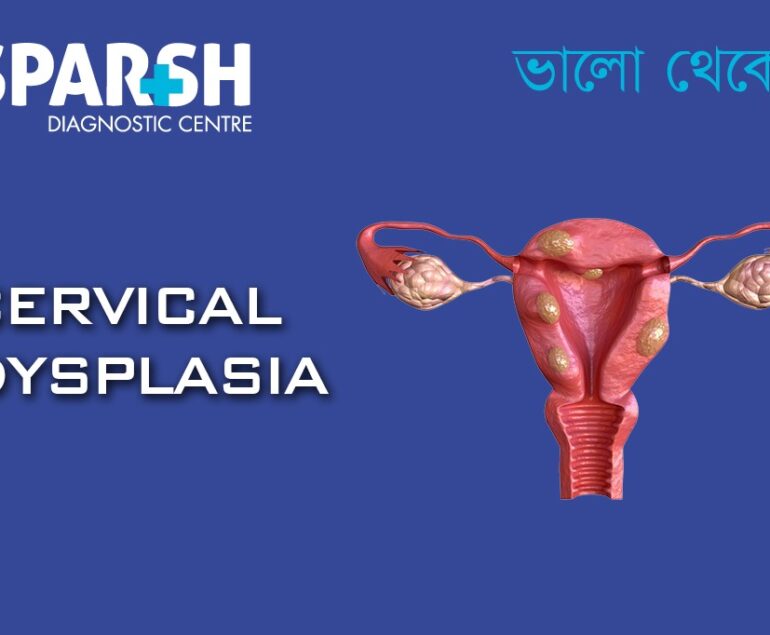Blood pressure regulation is a crucial component of maintaining cardiovascular health. While many people are familiar with high blood pressure (hypertension) and low blood pressure (hypotension), few have heard of orthostatic hypertension—a lesser-known but clinically significant condition. Unlike orthostatic hypotension (a drop in blood pressure when standing), orthostatic hypertension involves a sudden and sustained increase in blood pressure upon standing.
At Sparsh Diagnostic Centre, we believe in spreading awareness about such often-overlooked conditions so individuals can receive timely diagnosis and treatment. This comprehensive blog explores orthostatic hypertension in detail—its causes, symptoms, diagnosis, treatment options, and prevention strategies.
What Is Orthostatic Hypertension?
Orthostatic hypertension is defined as a sustained increase in systolic blood pressure of at least 20 mmHg upon standing, with a standing systolic blood pressure of ≥140 mmHg. It’s a condition where the body reacts abnormally to positional changes, especially from lying or sitting to standing.

Key Diagnostic Criteria:
Increase in systolic blood pressure ≥ 20 mmHg within 3 minutes of standing
Standing systolic BP ≥ 140 mmHg
Absence of other causes like stress or acute illness
Why Is Orthostatic Hypertension Important?
Orthostatic hypertension can indicate:
Early autonomic nervous system dysfunction
Increased cardiovascular risk
A precursor to sustained hypertension
A marker for cognitive impairment in elderly patients
While it may not always show symptoms, over time, orthostatic hypertension can contribute to organ damage, including the heart, kidneys, and brain.
Common Symptoms of Orthostatic Hypertension
Although many individuals may not experience symptoms, others may report:
Headaches upon standing
Dizziness or light-headedness
Vision disturbances
Palpitations or rapid heartbeat
Feeling flushed or anxious
Sweating
These symptoms are often transient, occurring shortly after standing up and may resolve on their own. However, persistent occurrences should not be ignored.
Causes of Orthostatic Hypertension
The exact mechanism of orthostatic hypertension is not fully understood, but contributing factors include:
1. Autonomic Nervous System Dysfunction
Normally, the autonomic nervous system adjusts blood pressure during posture changes. A dysfunction can lead to an exaggerated blood pressure increase on standing.
2. Aging
Elderly people are more prone due to vascular stiffness and decreased baroreflex sensitivity.
3. Overactive Sympathetic Nervous System
Excessive activation can result in vasoconstriction, increasing BP on standing.
4. Volume Depletion
Although paradoxical, dehydration may result in compensatory vasoconstriction, leading to elevated standing BP.
5. Diabetes
Long-standing diabetes can impair autonomic regulation.
6. Kidney Disorders
Impaired renal function can affect blood volume and electrolyte regulation, increasing BP variability.
7. Use of Certain Medications
Especially:
Stimulants
Decongestants
Risk Factors for Orthostatic Hypertension
Individuals with the following risk factors are more likely to develop this condition:
Age > 60 years
History of essential hypertension
Use of anti-depressants or BP medications
Family history of hypertension or stroke
Diagnosis of Orthostatic Hypertension
Diagnosis typically involves orthostatic blood pressure measurement:
Step-by-Step Measurement:
Patient lies down quietly for 5 minutes.
Measure BP in supine position.
Patient stands up.
Measure BP after 1 minute and again after 3 minutes.
An increase in systolic BP ≥ 20 mmHg upon standing confirms orthostatic hypertension.
Additional Diagnostic Tools:
Tilt table test
ECG or echocardiogram to evaluate heart function
Autonomic function tests
Blood and urine tests for renal and metabolic function
Complications of Untreated Orthostatic Hypertension
When ignored, orthostatic hypertension may lead to:
Persistent hypertension
Left ventricular hypertrophy (enlarged heart)
Stroke or transient ischemic attack (TIA)
Chronic kidney disease
Cognitive decline
Increased risk of falls and fractures in the elderly
Treatment Options for Orthostatic Hypertension
Management focuses on symptom control, blood pressure regulation, and addressing underlying conditions.
1. Lifestyle Modifications
Avoid rapid posture changes
Maintain adequate hydration
Limit caffeine and alcohol intake
Moderate salt intake (as advised)
Elevate head while sleeping
Engage in regular physical activity
Reduce stress through yoga or meditation
2. Pharmacological Treatments
There’s no single FDA-approved treatment, but medications used may include:
Beta-blockers (e.g., propranolol) to reduce sympathetic overactivity
Diuretics (with caution) to manage volume overload
ACE inhibitors or ARBs for patients with concurrent hypertension or kidney disease
Clonidine to reduce blood pressure surges
Adjusting or stopping medications that may worsen the condition
Always consult a physician before starting or stopping any medication.
Orthostatic Hypertension vs. Orthostatic Hypotension
| Feature | Orthostatic Hypertension | Orthostatic Hypotension |
|---|---|---|
| Blood Pressure Change | Rise ≥ 20 mmHg (systolic) on standing | Drop ≥ 20 mmHg (systolic) on standing |
| Symptoms | Headache, palpitations, flushing | Dizziness, fainting, blurred vision |
| Common In | Elderly, hypertensive patients | Elderly, patients with Parkinson’s or diabetes |
| Associated Risk | Cardiovascular complications | Falls, fainting, cognitive decline |
| Management | BP control, sympathetic suppression | Volume expansion, compression garments |
Living with Orthostatic Hypertension
Tips for Daily Management:
Stand up slowly from sitting or lying
Sit at the edge of the bed for a minute before standing
Avoid prolonged standing
Track BP readings regularly (keep a log)
Eat small, low-carb meals to avoid post-meal BP spikes
Consult your healthcare provider about medication timing
Monitoring and Follow-up
Routine follow-up is vital. At Sparsh Diagnostic Centre, we offer:
Regular blood pressure monitoring
Diabetes screening
Personalized treatment plans
Our experienced physicians can help you navigate orthostatic hypertension safely and comfortably.
When to Seek Immediate Help
Seek medical attention if you experience:
Severe headache or confusion
Chest pain
Difficulty breathing
Vision changes
Repeated fainting episodes
These may indicate complications requiring urgent intervention.
How can Sparsh Diagnostic Centre help
At Sparsh Diagnostic Centre, we provide:
Expert consultation and diagnosis
Advanced BP monitoring techniques
Full panel of cardiovascular and renal tests
Lifestyle and dietary counseling
Personalized medication reviews
Our goal is early detection and efficient management of lesser-known conditions like orthostatic hypertension to help you lead a healthier life.
Frequently Asked Questions (FAQs)
Q1: Is orthostatic hypertension dangerous?
Yes. If untreated, it can increase the risk of cardiovascular disease, kidney damage, and cognitive decline.
Q2: Can young adults get orthostatic hypertension?
Although more common in the elderly, it can affect younger individuals, especially those with nervous system disorders, diabetes, or who take stimulants.
Q3: Can I measure orthostatic hypertension at home?
Yes. Using a home BP monitor, you can measure readings lying down and after standing to compare. However, always confirm with a doctor.
Q4: Is it the same as white coat hypertension?
No. White coat hypertension is a temporary BP spike due to anxiety during clinic visits. Orthostatic hypertension is posture-induced.
Q5: Will I need to take medicine forever?
Not always. If diagnosed early, lifestyle changes may suffice. If medications are needed, your doctor will monitor and adjust treatment over time.
Orthostatic hypertension is an underrecognized but impactful condition that affects blood pressure regulation during posture changes. Timely diagnosis and effective management can prevent complications and improve quality of life.
If you or a loved one experiences unusual symptoms upon standing—don’t ignore them. Visit Sparsh Diagnostic Centre for expert evaluation and care. Our multidisciplinary team ensures comprehensive diagnosis and support to keep your blood pressure and overall health in check.
Need help with blood pressure monitoring or diagnostic tests? Contact Sparsh Diagnostic Centre at
📞 9830117733 / 8335049501
🌐 www.sparshdiagnostica.com
🕒 Mon to Sat: 7 AM to 9 PM | Sun: 7 AM to 3 PM
#BhaloTheko
Disclaimer:
No content on this site, regardless of date, should ever be used as a substitute for direct medical advice from your doctor or other qualified clinician.

![]()





